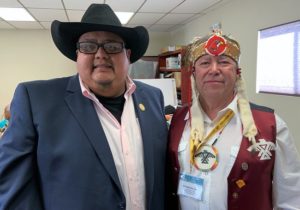Anishinabek Nation Regional Deputy Grand Council Chief visits Navajo Nation

From November 17-20, I travelled to Window Rock, Arizona, capital of the Navajo Nation, on behalf of the Anishinabek Nation along with other Anishinabek Nation delegates, as part of information reconnaissance on governance. Admittedly, I was one of the original Regional Grand Council Chief Deputies that questioned what the outcome was going to be from such a trip.
My experience I will share is that it was an eye-opener in how advanced they are in some areas but in other areas, I feel that we have progressed differently in our own governance building such as our modernization of the dodems (clans).
During the first meeting with the leadership and citizens of the Navajo Nation, I think our whole delegation noticed they introduce their clan first, then themselves and what clan and area they are from, and then where they reside. This is precisely what our Elder Gordon Waindubence has been teaching us for a long time.
Their Citizenship Code is stronger for their Nation and it is for the entire Nation, not just individual Chapters (reserves). All persons of Navajo Blood whose name appears on the official roll of the Navajo Nation, maintained by The Bureau of Indian Affairs, and any person who is at least one-fourth degree of Navajo blood is considered eligible for tribal membership. It was explained to us that at times, one-fourth degree can be appealed because of adoption; parents might be unknown but it is up to an Enrollment Screening Committee to decide.
Our Anishinabek Citizenship Law, E-Dbendaagzijig Naaknigewin, is a one-parent rule, but each individual First Nation can adopt their own law. Under the Navajo Law, clan-exogamy is exercised which means that citizens cannot marry into the same clan if they are married through their own justice and ceremony on Navajo Territory. However, it was noted that many citizens do marry outside of the Nation. Again, this is one of the teachings from our Elder Gordon Waindubence, but it is mostly over looked because how can we control when two people fall in love?
Our delegation had the opportunity to visit and sit in at the Chichiltah Chapter House District 16 regular community meeting. We noticed right away that the Nation follows the American political forms of government. There are 118 Chapters (First Nation Bands) and instead of Chief, it is President, Vice President, Secretary/Treasure and Land Board Officer.
Interesting point to note is that when a motion is brought forward by the President or Vice, it is voted on by members sitting from the community for that meeting; on the day of our visit, there may have been 30 in attendance. When community or Chapter funds are being used, such as a major purchase like a vehicle or equipment, it is very transparent to all.
I would recommend that the Anishinabek Nation education body, the Kinoomaadziwin Education Body, take a look the Navajo Nation Department of Diné Education (DODE) and the Navajo Sovereignty in Education Act which states:
“The Navajo (Diné) language shall be the instrument of educating, and reinforcing the importance of the continuation, comprehension and communication of the Navajo (Diné) language within the Navajo Nation Department of Head Start. The purpose of having the Navajo (Diné) language as an instrument of instruction within the Navajo Head Start program is to enable children to communicate freely and effectively through the Navajo (Diné) language, not as a second or foreign language but the language of the Navajo (Diné) people. The Navajo Nation is committed to ensure that the Navajo (Diné) language will survive and prosper. The Navajo (Diné) language must be used to ensure the survival of the Navajo (Diné) people and their future, to maintain the Navajo way of life, and to preserve and perpetuate the Navajo Nation as a sovereign nation.”
A couple of initiatives are in place to ensure the survival of the language. This includes the Diné Language Proficiency Assessment (DLPA), which is designed to measure students ability to understand and produce Oral Language at Grades K, 4th, 8th, and 12th.
There is also the Oral Navajo Language and Cultural Test (ONLC-T), a standard test designed to measure students’ developing ability to understand and produce oral Navajo Language and their knowledge on the Navajo culture. The test is administered to 4th, 8th, and 12th Grade students in Navajo Language & Culture classes. Teachers applying to positions within the Navajo Nation schools are also required to undergo testing of their own ability by the Nation, not a Municipal School Board.
The Navajo Nation is very advanced in terms of their Justice System. They have a sitting Supreme Judge and Nation Supreme Court Staff. We had the opportunity to meet the Honorable Eleanor Shirley, a permanent Associate Justice of the Navajo Nation Supreme Court.
The closest we have would be our Redress and Appeals Circle. They have the Peacekeeper model which would be very close to our project that was started about 10 years ago. They also practice something like the Gladue Report, which is a type of pre-sentencing and bail-hearing report that someone of Indigenous ancestry can request that would look at personal circumstances of the accused, including impacts of colonialism.
One other note, the Leadership and staff were all so very helpful and answered any questions we brought forward, great hosts.
They would like to learn more on our modernization of the Clan System, Economic Development, Education & Lifelong Learning, Health, Internal and External Governments, Social, Mediation, and so much more.
Miigwech,
James R. Marsden
Southeast Regional Deputy Grand Council Chief
Anishinabek Nation


